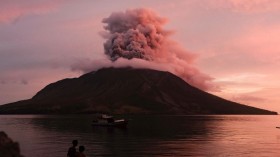Humans have long been blamed for driving American mastodons to extinction, but new research indicates that these ancient behemoths suffered from freezing temperatures long before hunters arrived on the scene.
Between about 10,000 and 125,000 years ago, the American mastodon (Mammut americanum) could be found roaming continental North America as well as Honduras and the Arctic coast of Alaska. They preferred to munch on the woody plants and twigs found in forests and lowland swamps, so "it would seem unlikely that they were able to survive in the ice-covered regions of Alaska and Yukon during the last full-glacial period, as previous fossil dating has suggested," lead author and paleontologist Grant Zazula said in a press release.
New radiocarbon dating on 36 mastodon fossils found in Alaska and Yukon suggests that these massive mammals made the warm Arctic and Subarctic a temporary home 125,000 years ago.
The climate in this region - known as eastern Beringia - was probably as warm as it is today. However, mastodons could not bask in the sun for too long, for cold, dry glacial conditions and advancing continental glaciers would soon take over the north. These freezing conditions wiped out their habitats and forced the ancient animals to vacate these lands about 75,000 years ago.
"Mastodons disappeared from Beringia, and their populations became displaced to areas much farther to the south, where they ultimately suffered complete extinction about 10,000 years ago," Zazula added.
These findings, published in the journal Proceedings of the National Academy of Sciences, go against all previous notions of what drove American mastodons to extinction.
A changing climate has long been one theory, a phenomenon that occurred at the end of the Ice Age about 10,000 years ago and wiped out mastodons, along with 70 other mammal species living in North America. And humans, who colonized the continent around 13,000 to 14,000 years ago and hunted mastodons for their meat and fur, were also a popular scapegoat.
However, now it appears that these mammals suffered local extinction several tens of millennia before either human colonization or climate change were relevant.
"We're not saying that humans were uninvolved in the megafauna's last stand 10,000 years ago," said co-author Ross MacPhee. "But by that time, whatever the mastodon population was down to, their range had shrunken mostly to the Great Lakes region. That's a very different scenario from saying the human depredations caused universal loss of mastodons across their entire range within the space of a few hundred years, which is the conventional view."
For more great nature science stories and general news, please visit our sister site, Headlines and Global News (HNGN).
© 2024 NatureWorldNews.com All rights reserved. Do not reproduce without permission.
![Extreme Heat Wave in Africa’s Sahel Region That Killed 100 People Linked to Climate Change [Study]](https://1471793142.rsc.cdn77.org/data/thumbs/full/70226/280/157/50/40/extreme-heat-wave-in-africa-s-sahel-region-that-killed-100-people-linked-to-climate-change-study.jpg)




